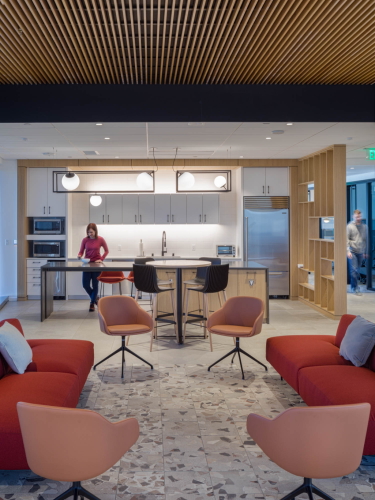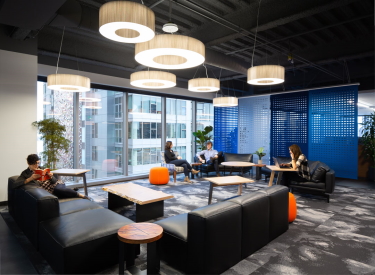|
Subscribe / Renew |
|
|
Contact Us |
|
| ► Subscribe to our Free Weekly Newsletter | |
| home | Welcome, sign in or click here to subscribe. | login |
Construction
| |

November 18, 2021
Selecting a general contractor for your TI? Focus on the fit and the rest will follow
Schuchart Construction
(Editor's note: This is the second of a two-part series covering the tenant improvement market. Part one ran on Nov. 12.)
A tenant improvement is more than increasing functional workspace, adding new amenities, or responding to the latest office trends. It is an investment in your business, and your workplace culture.
Previously, I wrote about the benefit of getting input from your most valuable stakeholders — your employees — about what your future workplace will look and feel like. Gaining insights into their needs is critical to ensure your new office will support your company's values and culture, both where it is today and how you want to evolve.
Translating the design of your tenant improvement into a real, functional office space requires a general contractor that understands your values and will carry your vision through construction. Selecting the right contractor for your project is all about doing your homework up front to find the right fit.
FOCUS ON THE FIT
When hiring a contractor for your next tenant improvement, do research and gather as much information as you can. How much experience do they have? Do they produce quality work? How do they communicate? Do they have a solid safety plan? Can they provide references? These are obvious things to look for right off the bat.
Additionally, your contractor needs to be a good fit for your project and provide the value you're looking for. And this value goes far beyond cost; your contractor should see your project as more than a transaction and be invested in its success. You should trust they understand your goals and will build a space that goes beyond day-to-day business activities and supports your company's overall purpose.
At Schuchart, whenever we kick off a new project we like to establish the client's wants versus needs. What parts of the space are most critical to get right, and what is driving those goals? Is a $50,000 reception desk non-negotiable, or is it more about making your new space inviting? We don't want to challenge the design vision, just make sure we maximize it within the budget.

If the client has been through a tenant improvement before, we find out what went well previously that they'd like to replicate. And we want to hear what didn't go so well, so we can improve that experience this time.
For us, we see every project as a partnership. We like to work with our clients, not for them; they should feel involved in the process as empowered decision-makers from day one.
HOW TO SET YOUR TENANT IMPROVEMENT UP FOR SUCCESS
We've collaborated on a countless variety of tenant improvements throughout the Puget Sound area. As a result, we've learned the common obstacles clients face. Beyond finding a contractor that fits your organization and supports your goals, there are things you can do as you approach your tenant improvement to ensure success, avoid pitfalls, and guarantee you'll enjoy the process.
Ask the right questions
There shouldn't be any ambiguity around how you and your contractor will work together. In addition to the questions listed earlier, prevent misaligned expectations by getting specific:
• What is their safety record? Do they have a history of OSHA shutdowns or workplace injuries?
• What is included in the cost estimate? What isn't? Are you getting everything you're asking for?
• Will they regularly update you on schedule and budget, hold weekly OAC meetings, provide progress photos, etc.?
• What is their expectation around your involvement and participation?
Bring your contractor on early
Don't wait for the pricing, permit, or CD set to hire your general contractor. Bringing them on early (after schematic design) can help set expectations, establish schedule milestones, and determine a realistic budget. Lean on your contractor's insights and experience to inform your design, especially in today's market; they can identify permitting obstacles, inspection issues, or supply chain disruptions affecting lead time, preventing future schedule delays or change orders.
Be up front about your budget
Your budget, and what you get for it, is paramount. You may be reluctant to share it with your contractor because you want them motivated by your project goals rather than how much they can spend. However, keeping that information from your project team makes it difficult for your contractor to advocate for you during the build-out, because they don't clearly understand your budget parameters.
Being transparent about your budget goes a long way in ensuring your expectations are met. When you hire a general contractor that is a good fit for your project, you can trust they'll prioritize your budget with your best interests at the forefront.
Stay engaged
This is your future working environment; ending up with a space you're happy with requires being invested in the process. Jerri Tuck, owner of J9 Management, understands this first-hand.
“As an owner's representative it's my job to make sure the client's expectations are clearly communicated to the project team,” she says. “An engaged client is an effective client, and an effective client is critical in making sure their expectations are met.”
Clearly communicate and be present. That way, all parties will be working toward a common goal with a shared understanding of what success looks like.
Have realistic expectations
One of the biggest issues we see with tenant improvements is inconsistency between a client's vision and what is feasible. Be up front with your project team about what you want, and listen to the feedback you receive. Be prepared for them to tell you what you need to hear, even if it's not what you want to hear.
You've hired your contractor for a reason; trust that they're coming from a place of good intention. Be open to their suggestions and have direct conversations so everyone is aligned. You'll avoid disappointment, and you may realize that what you thought was a priority isn't after all (remember that $50,000 reception desk?).
There are many moving pieces that go into a tenant improvement project. The key is having a general contractor that understands your company's culture and values, and that you can rely on to keep your best interests in mind.
By hiring a contractor that is the best fit, bringing them into the conversation early, and openly communicating budget, goals, and expectations, you can trust your general contractor will deliver a space that meets business needs and supports your culture. At the end of the day, you need to enjoy your new space and the process that got you there, even long after your contractor has left the building.
Travis Harth manages the Tenant Improvement Division at Schuchart, overseeing all of the company's commercial tenant improvement projects throughout the Puget Sound region.
Previous columns:
- The future of tenant improvements calls for a long-term investment in company culture, 11-12-2021
- Young Skanska project engineer overcomes cultural, work challenges, 11-04-2021
- Finnish company develops lightweight hybrid sandwich walls, 10-28-2021
- Skanska marks 75 years in Seattle with a look back by 3 families who were a big part of that history, 10-21-2021
- Wearable devices connected to the internet offer added safety for construction workers, 10-14-2021
- Dubai's Expo 2020 reveals 3 worker deaths from COVID and 3 more from construction incidents, 10-07-2021
- Local construction managers say a personalized approach will help the future of school design, 09-30-2021
- Using arbitration can be quick, flexible and inexpensive as the pandemic rages on, 09-23-2021




